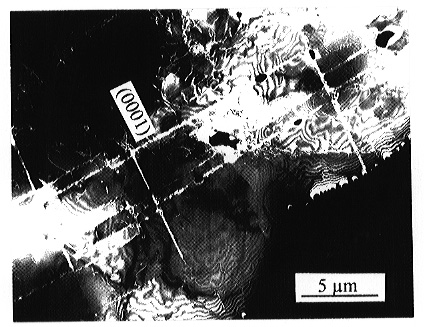

The approximately 200 km wide Chicxulub impact structure in Yucatan, SE Mexico, most probably represents the impact event that caused the Cretaceous-Tertiary (K/T) boundary mass extinction. This structure is buried under approximately 1 km of Cenozoic carbonates and evaporites. Impact-induced degassing of these sediments has been suggested to be a major killing mechanism in the K/T scenario. Direct access to samples inside the crater is essential for the understanding of this structure and the mass extinction. Therefore, the International Continental Drilling Program (ICDP) has selected Chicxulub as drilling site. The aim of this study was to characterize the shock metamorphism and impact petrology of core samples from two wells (Y6 and C1), previously drilled by PEMEX. These data are needed to select the new drill sites of the ICDP.
Core samples were studied by optical and electron-optical methods. Sample
C1 represents a clast-free impact melt rock, whereas core samples from
Y6 are polymict impact melt breccias (suevites) with silicate and carbonate
groundmasses. The Y6 samples have been studied in more detail because various
degrees of shock metamorphism are recorded in lithic and mineral clasts.
Mineral clasts consist of quartz, feldspars, and anhydrite; lithic fragments
are composed of crystalline basement rocks and fossiliferous limestones.
Shock features in quartz and feldspar clasts are decorated planar deformation
features (PDFs) and diaplectic glasses. As revealed by TEM, some decorated
PDFs in shocked quartz represent mechanical Brazil twins parallel to (0001)
(Fig. 3.4-2). Due to post-shock annealing, diaplectic glasses in some samples
are recrystallized to so-called ballen quartz and checker-board feldspars.
Anhydrite clasts do not show any sign of shock metamorphism. The silicate
matrix of impact melt breccias is dominated by clinopyroxene, plagioclase,
and interstitial K-feldspar, and quartz.
 |
|
So far, these results clearly attest to the impact origin of the Chicxulub structure. Further studies will focus on the shock behaviour of calcite and anhydrite. The devolatilization of these minerals is of fundamental importance for understanding the mass extinction pattern at the K/T boundary.

Tel: +49-(0) 921 55 3700 / 3766, Fax: +49-(0) 921 55 3769, E-mail: bayerisches.geoinstitut(at)uni-bayreuth.de
 Previous page
Previous page